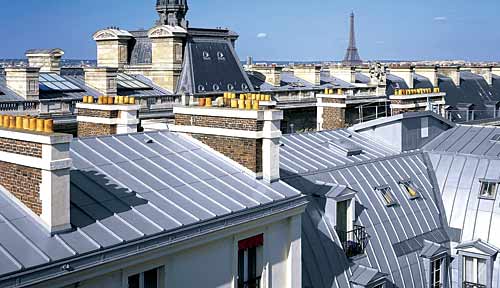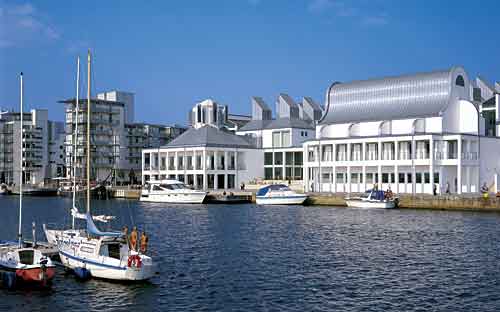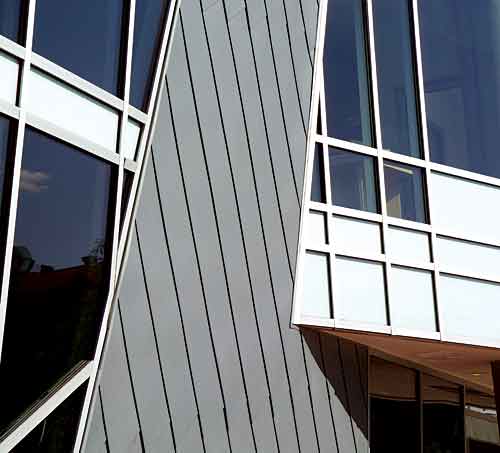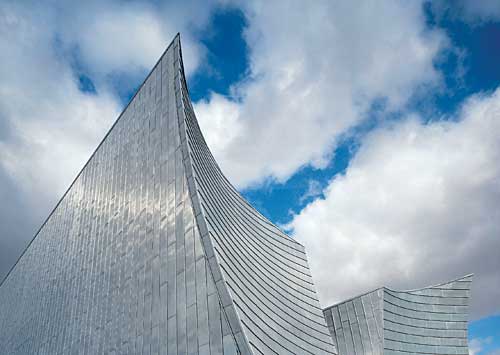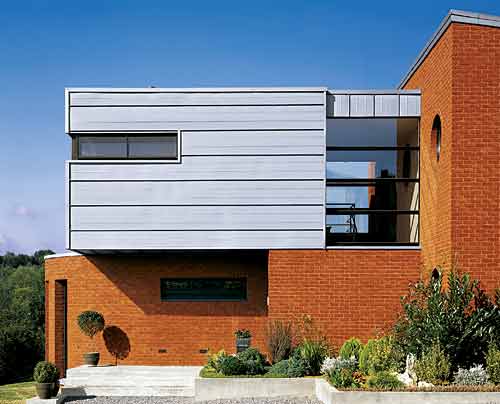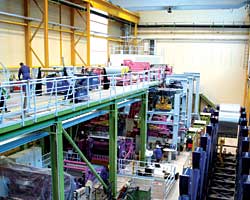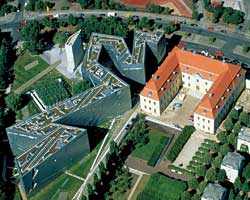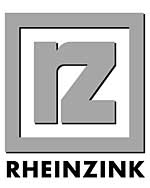Architectural Zinc: From Gray to Green
A traditional building material finds a green future
![]() Continuing Education
Continuing Education
Use the following learning objectives to focus your study while reading this month’s Continuing Education article.
Learning Objectives - After reading this article, you will be able to:
- Identify zinc's chemical and physical properties related to sustainable building.
- Discuss the reasons for architectural zinc's long-term durability and inherent recyclability.
- Examine the environmental profile of architectural zinc through its entire life cycle.
When Baron Haussmann renovated Paris for Napoleon III beginning in 1853, he used zinc extensively, and the beautiful rooftops of today's Paris are still over 80 percent zinc. Now architects are turning to this long-used traditional material for reasons far beyond its storied past. Unbeknownst to the Baron, zinc has chemical and physical properties which make it one of the most environmentally benign building materials available, virtually 100 percent recyclable and ecologically friendly at every step in its life cycle.
Though known for generations in Europe for its beauty, versatility and extreme durability, the concept of zinc as a green building material playing a positive role in the environment may be less familiar. The characteristics that set architectural-grade zinc apart from other metals, and in fact from many other building materials, are just now beginning to be part of the environmental calculation in the United States.
This article will illustrate the environmental profile of architectural-grade zinc alloys-used in buildings for roofs, facades, and rainwater systems-over their entire life cycle, from production through use and re-use. The focus will be on how zinc's chemical and physical properties, the history and technology of its long-term durability, and its inherent nearly 100 percent recylability qualify this metal as a green material.
Essential Element
Zinc is present throughout the natural environment, in the earth, air and water. Zinc is essential to all life, a fundamental part of the metabolic processes of plants, animals and humans. In the human body, over 300 enzymes require zinc for proper functioning. Zinc is already an ingredient in vitamins, supplements, cold lozenges, toothpaste and other pharmaceuticals, and positive effects on human health in areas such as anti-oxidant activity, eye health, disease and aging prevention and many others are being intensively studied.
Ingesting a heavy metal to improve your health might seem counterintuitive, because the term "heavy" is often read as "toxic." But the definition of "heavy" actually refers only to specific gravity, a term relating to the heaviness of a substance compared to that of water. "Heavy" metals have a density of over 5 g/cm3 and light metals less than that. Some heavy metals, such as lead, are toxic. Others, like zinc, are distinctly non-toxic, a trace element that is indispensable for all living organisms.
|
The essential nature of zinc means that run-off from today's zinc building material is clear and safe. In fact, zinc is used for rainwater drainage systems such as half-round gutters. Popular in Europe for both form and function, they are beginning to be used more widely in this country. In contrast to some synthetic building materials, architectural zinc alloy contains none of the impurities that can leach heavy metals into the soil or release them into the atmosphere.
Physical Protection
Zinc's elemental protective properties show themselves in almost all its applications, from its use in human health to nutrition for soil, agricultural crops and animals. Zinc coatings protect steel in the construction industry. Being a "sacrificial" metal, zinc will "sacrifice" itself to protect the steel, preventing corrosion and lengthening steel's life by at least a factor of five. However, as a building material, solid architectural-grade zinc is even more effective.
A distinction must be made between solid and coated metals. Coatings come in many forms, including galvanizing, lead-coating, terne-coating and painting. Coated metals require additional energy to have the coating applied, and some surface treatments use toxic ingredients.
|
But with solid zinc, no paint, varnish or sealants, or maintenance of any kind, are required. When a treated surface is scratched, the coating is gone. Of all the forms of coating, certainly none are self-healing after the coating has been scratched away. Regardless of the coating or its method of application, its durability is limited. Whether it has been scratched off or it has faded away, no coating will last as long as its base metal. Eventually it will break down, requiring maintenance. In contrast, a roof or wall of solid zinc alloy is self-healing and self-maintaining.
The key to the extraordinary durability of zinc roofs and facades, and often cited as the source of their beauty over time, is patination. Just as copper ages from orange to green, zinc over time develops its distinctive patina, going from shiny silver to matte bluish gray (depending on the precise alloy, other colors and finishes are also possible). In contact with the water, oxygen and carbon dioxide molecules in the atmosphere, the surface forms a closely adhering protective layer of zinc carbonate, which is insoluble in rainwater and will hinder any further exchanges between oxygen and zinc, thereby protecting the zinc from further corrosion. Zinc continues to renew this protective layer throughout its life, although the heaviest formation is usually complete in about five years, and will self-repair any imperfections or scratches.
Zinc and More Than Zinc
In its pure form elemental zinc is too soft and brittle for architectural applications. Architectural-grade zinc is an alloy providing both the malleability and strength for architectural profiling. Precise alloy formulas are proprietary and highly engineered, but they typically consist of purified zinc-99.995 percent pure-plus very small amounts of titanium, which improves tensile strength and hardness and reduces the coefficient of expansion, as well as copper, which improves workability.
|
Since the purity and quality of the zinc alloys is so important to their performance, exacting independent certification criteria have been established. The TÃœV Quality Zinc certification awards a label to products that meet strict testing criteria, particularly for mechanical and technological properties and chemical composition. International standards also exist for zinc manufacturing (see "Zinc Standards" in the online section of this article).
Time-tested Durability
Two distinct but closely related attributes of zinc in buildings are major factors in its overall environmental performance: its durability and recyclability. This durability is not theoretical. Long before the advanced alloys of today (and before anyone suspected that the environment was not eternal), especially in the unforgiving climates of northern Europe, zinc roofs were prized for their longevity, resistance to corrosion, low maintenance, relative light weight and the workability that lent itself to traditional craftsmanship at a very high level. The widespread application of zinc in roofing and wall cladding began in the 19th century (although there are earlier buildings still extant). Often these were civic buildings and cathedrals, built to last for generations, if not forever. Some of these roofs are still in service. The tradition continues to be strong in Europe, where zinc is a much more widely used building material than in this country.
|
Today, zinc products used in architecture for roofs and walls have an extremely long service life: an estimated 80 to100 years for roofs, and 200 to 300 years for walls, depending on the exact product, geographic location and local conditions, including the amount of air pollution.
Durability is a key component of sustainability. The National Institute of Standards and Technology defines Life Cycle Cost as the total discounted dollar cost of owning, operating, maintaining and disposing of a building or building system over a period of time. The service life over which zinc materials are evaluated is much longer than with almost any other building material.
Durability is not only a matter of simple longevity, but also of the costs necessary in maintaining a material throughout its life, and those involved in disposing of it at the end (or, ideally, at the beginning of its use in yet another product). To take roofs as an example, in a 2004 study conducted by Ducker International, owners and property managers reported performing little or no maintenance on their metal roofs (the study included all types of metal roofs, not just zinc). A comparison of maintenance costs over the life of the roof for metal versus asphalt and single-ply showed that owners of metal roofs spent approximately 3 percent of total installed costs on maintenance, versus 28 percent for asphalt and 10 percent for single-ply.
|
For most conventional roofing materials, their removal, disposal and replacement, on average every 17 years but in many cases more often, also represents a major environmental factor. The need for multiple roofs over a building's lifetime makes roofing materials a large contributor to the waste stream. For example, it is estimated that at l east 9 to 10 million tons of asphalt roofing materials from tear-offs and installation scraps ends up in landfills every year. A 2007 Army Corps of Engineers technical bulletin cites an estimate that 7 to 10 percent of the nation's landfill space has gone to roofing waste over the last 40 years. An asphalt shingle will take some 300 years to decompose.
When costs are extended over multiple generations, the sustainability of building components with very long service lives-even those with relatively higher costs at some points in their life cycle-may be better, and their overall environmental impact lower, than that of alternatives with much shorter service lives and problematic maintenance, repair and replacement profiles.
Zinc material requires little maintenance over its service life; its patina constantly renews itself as it weathers and ages and will "heal over" scratches and imperfections, requiring no touch-up or repainting. Because the metal is uncoated, there is no possibility of the fading, chipping or peeling that otherwise needs recurrent attention. A single zinc roof, with a lifespan of 80 to 100 years may well outlast the building it has been sheltering. And if or when zinc material is removed, it will never see a landfill.
Green Life and Afterlife
Some common materials, such as certain plastics, are often referred to as "recyclable" and that's factual, they can be recycled: once. At some point the chain-like molecular structure of most plastics break down.
In another example, wood in some life cycle calculations is favored as a rapidly renewable, easily recycled material. But wood, which according to EPA represents 20 to 30 percent of construction waste, is not always straightforward to recycle due to paints, sealants, nails and other possible toxins and the necessity for careful sorting. Even when reclaimed for recycling, used and discarded wood that escapes the landfill will in large part end up as a lower value product such as mulch or feedstock for particleboard.
|
Metallic zinc can be recycled indefinitely without loss of its chemical or physical properties. This theoretically infinite recyclability is, in fact, being approached in reality in the case of zinc used in buildings.
Architectural-grade zinc must be very pure, and so it contains higher percentages of pure ore than industrial-grade zinc. However, once the pure architectural alloy has been created, it can be recovered and reprocessed for use in new architectural products. Some current zinc manufacturers achieve very high levels of this recycled content in their architectural zinc, over 45 percent, almost all of which is post- consumer content. The overall recycling rate for architectural zinc-for example, recovered from renovations and removal from old building-is over 90 percent in some countries because of its high value and the preservation of all its chemical and physical properties. Not all of the old buildings with zinc components were precious monuments to be preserved for all time. Buildings whose zinc parts outlasted them are numerous in Europe. Virtually no zinc on a building ever goes to a landfill.
Recycling of zinc is a well-established industry because products can be recovered easily at the end of their life and there is an extensive network of buyers offering advantageous prices. Even small amounts of scrap zinc generated on jobs are valuable and readily sold.
The amount of energy used to produce zinc from ore is already the lowest of non-ferrous metals, as discussed further below. But recycled zinc conserves approximately 95 percent of that initial energy content. It is also energy efficient to reprocess. Only a fraction-between 0.49 percent and 19.7 percent-of the energy used to produce zinc from ore is necessary to produce zinc from recycled material.
|
Designing with Zinc: Green into the Future
Architects all over the world have long been in agreement that zinc is beautiful and durable. However, now that the distinct environmental benefits of zinc throughout the life of the building-and well before and beyond-are becoming known, the nature of the cost calculation is changing. The reasons why a zinc roof on the oldest building in a northern European town may be next door to the compound curves and complex geometries of the newest, most innovative building in town are directly related to the environmental benefits of today's zinc alloys.
And some day, when one of the Baron's rooftops is finally removed, it will no doubt go on to another life, with luck in a new building in the future where it will be valued for its sustainability, its durability, its positive response to the atmosphere and environment, and, not least, its enduring beauty.
|
||||
The Environmental Profile of Zinc in Buildings: Green Life Story
The current process for extracting, processing and recycling zinc materials is based on technological innovations, some only a few years old, and continuing at a rapid pace, to save energy, contain and re-use potentially harmful by-products, and recycle material at every phase.
Its low embodied energy is one important way that zinc is a green material. Embodied energy includes the total amount of non-renewable energy needed to create one unit of a finished product, including raw material extraction, transport, manufacturing, assembly and installation, and in detailed calculations, to maintain during its useful life and dispose of afterwards. The terms "cradle to grave," "cradle to cradle" and "total cost of ownership" describe this.
Among the non-ferrous metals used in building, zinc has the lowest embodied energy. It is the least energy intensive to produce, requiring one fourth the energy of aluminum, and one third that of copper or stainless steel. Zinc is less expensive to extract than many other metals, and requires lower heat and less energy to process.
Raw Material and Resource Consumption:Zinc is the 23rd most abundant element in the earth's crust. Increased recycling, currently at a yearly rate of over 30 percent of overall zinc consumption, is also expected to increase and to compensate for future growth in consumption. Zinc is mined worldwide, and various projections have been made for the size of the global supply, but estimates put it up to 750 years at current extraction levels.
Mining: Zinc is predominantly mined from deep mines as opposed to strip mines. Core extraction mining, although more expensive, requires less energy, disturbs less land and risks less environmental damage than strip mining. Zinc is easier to extract than other metals, requiring less gross energy consumption. Zinc alloy manufacturers also have the option of purchasing zinc ingots from suppliers who contract with environmentally conscious mining companies. Current global sustainability initiatives and increased regulatory scrutiny are driving new energy efficient and ecologically low-impact processes.
Smelting and Processing: Emissions during these phases are reduced to a minimum through state of the art manufacturing equipment including new furnaces, heating and cooling systems and electrofilters and other abatement systems that minimize waste and pollution, conserve energy and limit the release of emissions. Zinc has a low melting point of 786 °F (419 °C) compared to aluminum at 1120 °F (660 °C), copper at 1983 °F (1084 °C), and steel at 2372 °F (1300 °C) resulting in lower energy requirements at the smelting stage of production.
Maintenance:The installation of zinc products on job sites typically results in very little pollution and little or no waste, since even scraps have resale value. As discussed above, repair and maintenance costs tend to be minimal throughout the life of the building.
Replacement and Disposal-or Recycling:Replacement costs are likewise few and far between during the long lifetime of zinc materials -80 to100 years for roofs, 200 to 300 for walls and other building systems. Very few common building materials, including those considered to have low embodied energy, can match the recyclability of zinc material. Removal and disposal of typical building material can be a complex and costly job, and the resulting debris may have low or no value and end up in a landfill, with the associated costs for freight and disposal and the long-term cost to the environment (and the landfill will charge for this privilege). A complete environmental balance sheet must also take into account the high dollar and energy costs of labor to repair or remove old systems such as asphalt roofs, the cost of the replacement materials, the costs and energy used in transportation of materials on each occasion, and tipping fees at landfills.
An estimated 95 percent of the energy content embodied in a zinc product is conserved during recycling. Of the millions of tons of discarded building materials taken to landfills every year, there is hardly a scrap of architectural zinc.
|
Zinc Check: Did You Know?
- Zinc is constantly transported through the environment in a process called natural cycling. Released from rocks by sun, wind, ice and rain, and in larger amounts by forest fires, volcanoes and dust storms, natural zinc is transported to rivers, lakes and ocean where sediment and sea spray carry it further and the process begins again. The exact concentrations of zinc in nature vary continuously according to location, weather and even season-the leaves falling in autumn increase the concentration of zinc in the soil and water.
- Among the conclusions of an extensive 2001 report on zinc in the environment and human health by the World Health Organization, "Zinc EH 221, 2001" (available online atwww.inchem.org), is the following "The essential nature of zinc, together with its relatively low toxicity inhumans and the limited sources of human exposure, suggests that normal, healthy individuals not exposed to zinc in the workplace are at potentially greater risk from the adverse effects associated with zinc deficiency than from those associated with normal environmental exposure to zinc."
- Zinc-covered telegraph poles installed in the Australian outback in the late 19th century continue to be in good shape today.
- Zinc in all applications is a valuable commodity in the marketplace, and much of the zinc used today was first used years ago and probably many times since. You use zinc a great deal, whether you know it or not, in your car, batteries, electronic components, and many other applications, including the pennies in your pocket which, since 1982, are mainly composed of zinc.
- At least 30 percent of the zinc used in all applications worldwide comes from recycled zinc products, a number that is growing as the technology rapidly evolves for capturing even minute amounts of zinc, from the coatings on galvanized steel to the dust released during processing. Zinc is recycled at all stages of production and use-for example, from scrap that arises during the production of galvanized steel sheet, or is created during manufacturing and during installation -not just at the end of its product's service life.
- It is estimated that almost 80 percent of the total zinc that could be recycled with current methods is recycled.
- For architectural-grade zinc building materials, the picture is particularly favorable; between 90 and 95 percent is recycled.
- Depending on the exact product and application, special temporary organic coatings can be applied to protect the zinc surfaces during transportation and installation, and coatings can be applied on the underside of roofing products to protect against moisture that could be trapped in poorly ventilated roof situations. These coatings require no maintenance during the products' operating life.
- Emissions of zinc into atmosphere and water have been drastically reduced over the last twenty years. Extensive testing shows near- background levels (or, in another measure, levels in the optimal range) in the sea, in Greenland ice, in the Rhine River and many other locations (see the World Health Organization report cited earlier). Controlled emissions (e.g., point source emissions) from industrial processes; fugitive emissions resulting from mining, handling or transport operations or from leakages from buildings and insufficient ventilation; and diffuse emissions from the use of zinc-containing products have all been substantially reduced. More efficient emission control technology and changes in zinc refining methods and other industrial processes have resulted in decreases of emissions of 73 percent to air and 83 percent to water during the period 1985 to 1995 (Source: Royal Belgian Federation of Non-Ferrous Metals, 1995). These data are confirmed by the results of the U.S. Toxics Release Inventory during the period 1988 to1993.
- In addition to better technology and management practices, the reduction of zinc present in the atmosphere is due to another important factor: corrosion of exposed zinc surfaces has decreased markedly during the last two decades, as a direct consequence of the decreasing acidity of the air in the industrialized world, as a result of stringent control of sulphur dioxide emissions. The reduction of acid rain due to controls instituted in industrial countries in the past twenty years have not only reduced emissions into the atmosphere, but are also contributing to even longer life in zinc material surfaces, thus completing the circle by reducing corrosion from the surfaces.
|

